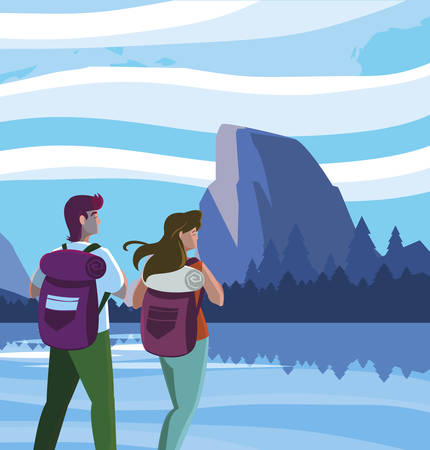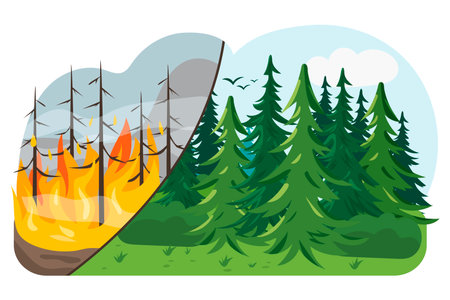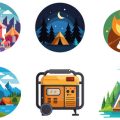Understanding Local Weather Patterns
Before you head out for your first camping trip in the U.S., it’s essential to understand the local weather patterns of your destination. America’s diverse geography means weather conditions can vary dramatically from one region to another, and even within a single state. Start by researching your campsite’s location—whether you’re headed to the Pacific Northwest, the desert Southwest, or the humid Southeast, each area has its own unique climate and seasonal risks. Check the typical weather for your planned travel dates, paying attention to historical data on rainfall, temperature swings, and wind speeds. Don’t just rely on general forecasts; instead, use trusted sources like the National Weather Service or local news outlets to get up-to-date and region-specific information. Understanding how to interpret weather forecasts—such as recognizing warnings for thunderstorms, heat advisories, or strong winds—can make a huge difference in how you prepare and stay safe outdoors. Remember that U.S. regions are known for fast-changing conditions; mountain areas can go from sunny to stormy in minutes, while coastal zones may face sudden fog or heavy rain. By learning about local weather trends and being aware of seasonal changes and regional risks, you’ll set yourself up for a safer and more enjoyable camping experience.
Gear Essentials for Weather Protection
When it comes to camping, being prepared for unpredictable weather is key—especially for beginners. Equipping yourself with the right gear will make your outdoor experience safer and a lot more enjoyable, no matter what Mother Nature throws your way. American campers rely on tried-and-true items designed to withstand rain, wind, and heat. Below, youll find a breakdown of must-have gear that should be at the top of your packing list.
Rain Protection
Nobody likes waking up in a soggy tent or hiking in drenched clothes. The following essentials keep you dry and comfortable:
| Item | Description | Popular Brands |
|---|---|---|
| Waterproof Tent | Tents with sealed seams and rain flies are crucial for keeping out moisture. | REI, Coleman, Big Agnes |
| Poncho or Rain Jacket | Lightweight and breathable options protect you on the go. | Columbia, Patagonia, The North Face |
| Dry Bags | Keep clothes and electronics safe from water. | Sea to Summit, Osprey |
Wind Protection
The wind can turn a peaceful night into a noisy ordeal. Here’s what American campers trust:
- Sturdy Tent Stakes: Heavy-duty stakes help secure your tent against strong gusts.
- Tarp or Windbreak: Set these up to shield your campsite from direct wind exposure.
Heat Protection
If you’re camping during summer or in sunny areas, overheating can quickly become an issue. These items help you beat the heat:
| Item | Description |
|---|---|
| Wide-brim Hat & Sunglasses | Protects your face and eyes from harmful UV rays. |
| Sunscreen (SPF 30+) | A must-have for any exposed skin. |
| Cooling Towels & Refillable Water Bottles | Keeps you hydrated and cool throughout the day. |
Packing Tips for Beginners
- Always check the forecast before leaving home and adjust your gear accordingly.
- Pack lightweight versions of rain and heat protection gear to save space in your backpack.
The Bottom Line
The right gear doesn’t just add comfort—it keeps you safe when weather conditions change. Investing in quality equipment popular among American campers means you’ll be ready to tackle whatever nature has planned for your next adventure.

3. Setting Up a Safe Campsite
Choosing the Right Spot
When camping in the U.S., selecting your campsite with weather safety in mind is crucial. Avoid low-lying areas where rainwater can collect and potentially flood your tent. Instead, look for slightly elevated ground that provides natural drainage. Steer clear of pitching your tent directly under dead tree branches, also known as “widowmakers,” which can fall during high winds or storms. If possible, find a spot sheltered by healthy trees or natural barriers to break strong gusts of wind without risking falling debris.
Setting Up Your Tent
Always set up your tent on a flat surface to ensure comfort and stability, but make sure it’s not at the lowest point in the area. Use a ground tarp beneath your tent to help prevent moisture from seeping in when it rains. Stake down all corners securely and use guy lines to brace your tent against wind—most modern tents have loops or attachments specifically for this purpose. Face the entrance of your tent away from prevailing winds, which are often stronger in open American campgrounds, especially in the Midwest and Southwest.
Positioning Equipment Safely
Keep your gear organized and stored inside your tent or in waterproof containers to protect it from sudden downpours. Place cooking equipment and food storage at least 200 feet away from your sleeping area, not only for bear safety but also to avoid attracting animals during storms. Never use stoves or lanterns inside your tent; always cook outside in a well-ventilated area protected from wind by natural features or windbreaks you create with tarps. Finally, ensure that all loose items are secured before nightfall or when leaving camp—unexpected gusts can scatter gear quickly across campsites.
4. Staying Safe in Wet and Stormy Conditions
When camping, unexpected rain and storms can quickly turn an enjoyable trip into a challenging experience, especially for beginners. Preparing for wet weather is essential for your safety and comfort. Here are some practical guidelines to help you manage heavy rain, thunderstorms, and the risk of flash floods during your camping adventure.
Preparing Your Campsite
Before setting up camp, always check the local weather forecast and avoid low-lying areas that may flood easily. Choose a site on higher ground, away from rivers or streams. Ensure your tent has a durable rainfly and set up a ground tarp underneath to prevent water from seeping in. Secure all gear tightly, as strong winds can knock over equipment or blow items away.
What to Do During Rainstorms
| Action | Why Its Important |
|---|---|
| Stay Inside Your Tent | Prevents getting soaked and keeps you warm |
| Avoid Touching Tent Walls | Keeps moisture from leaking inside |
| Keep Gear Dry | Wet clothes increase risk of hypothermia |
Thunderstorm Safety Tips
- If you hear thunder, seek shelter immediately—avoid open fields and isolated trees.
- Do not use metal-framed camping equipment during lightning activity.
- If you cannot reach shelter, crouch down on the balls of your feet with your head tucked in.
Flash Flood Preparedness
- Never camp in dry creek beds or near riverbanks, as these areas can flood rapidly.
- If heavy rain persists, move to higher ground immediately—even at night.
- Listen to emergency alerts on a portable weather radio if possible.
The table below summarizes key do’s and don’ts for wet and stormy conditions:
| Dos | Donts |
|---|---|
| Set up camp on high ground | Camp near streams or rivers |
| Keep emergency gear accessible | Ignore severe weather warnings |
| Peg down tents securely | Leave food or gear unsecured outside |
By following these beginner-friendly guidelines, you’ll minimize risks and stay safer when the weather takes a turn for the worse during your camping trip.
5. Protecting Yourself from Extreme Heat
American summers can bring intense heat, especially in popular camping regions like the Southwest, Midwest, and Southeast. For beginners, staying safe in high temperatures is all about preparation and smart choices. Start by wearing lightweight, light-colored, and moisture-wicking clothing to help your body stay cool. Avoid dark colors, which absorb more heat from the sun. Opt for a wide-brimmed hat and UV-blocking sunglasses to shield your face and eyes.
Stay Hydrated
Dehydration is a real risk during hot weather camping trips. Always bring more water than you think youll need; a good rule of thumb is at least one gallon per person per day. Keep a reusable water bottle with you at all times and take frequent sips—even before you feel thirsty. Include electrolyte drinks or powder packets to replenish minerals lost through sweat.
Find and Create Shade
Direct sunlight can quickly lead to overheating. Set up your tent or campsite under natural shade whenever possible—look for leafy trees or large rocks. If no shade exists, bring a pop-up canopy or tarp for a DIY shelter. Schedule strenuous activities for early morning or late evening when temperatures are lower, and rest in the shade during peak afternoon heat.
Sun Safety Essentials
Never underestimate the American sun, even on cloudy days. Apply broad-spectrum sunscreen (SPF 30 or higher) to all exposed skin every two hours, and after swimming or sweating. Wear protective clothing with built-in UPF ratings if available. Remember that kids are especially sensitive to sunburn, so keep them covered and shaded as much as possible.
With these practical steps—dressing smartly, prioritizing hydration, seeking shade, and practicing sun safety—youll be well-equipped to handle extreme heat on your next camping adventure.
6. Weather Emergency Procedures
When severe weather hits during your camping trip, having a clear emergency plan is crucial for safety.
Seeking Shelter
If you encounter extreme weather such as heavy rain, strong winds, or intense heat, seek shelter immediately. Avoid staying in tents under large trees due to the risk of falling branches during storms. If you’re at a campground with designated storm shelters or solid structures, head there as soon as possible. In the absence of official shelters, your car can provide safer refuge from lightning and wind than a tent.
Communicating Emergencies
Always keep your cell phone charged and within reach in case you need to contact emergency services (dial 911 in the U.S.). Let someone outside your group know your location and plans before you head out, so they can alert authorities if you don’t check in as scheduled. Walkie-talkies or weather radios can also be valuable in areas with poor cell reception. Know how to describe your exact location using landmarks or GPS coordinates to help rescuers find you quickly.
Using Local Resources
Familiarize yourself with local resources before setting up camp. Many campgrounds have posted evacuation routes and emergency contacts; take a photo or make a note of these on arrival. Pay attention to weather alerts from the National Weather Service or local park rangers, who may provide real-time updates about changing conditions. Don’t hesitate to approach staff or other campers for assistance if you’re unsure about what steps to take during a weather emergency.
Final Tips
Stay calm and act quickly when weather emergencies arise. Practicing drills with your group before bad weather strikes can help everyone remember what to do under stress. Preparedness is key—by knowing how to seek shelter, communicate effectively, and use local resources, you’ll protect yourself and others while enjoying the great outdoors.


